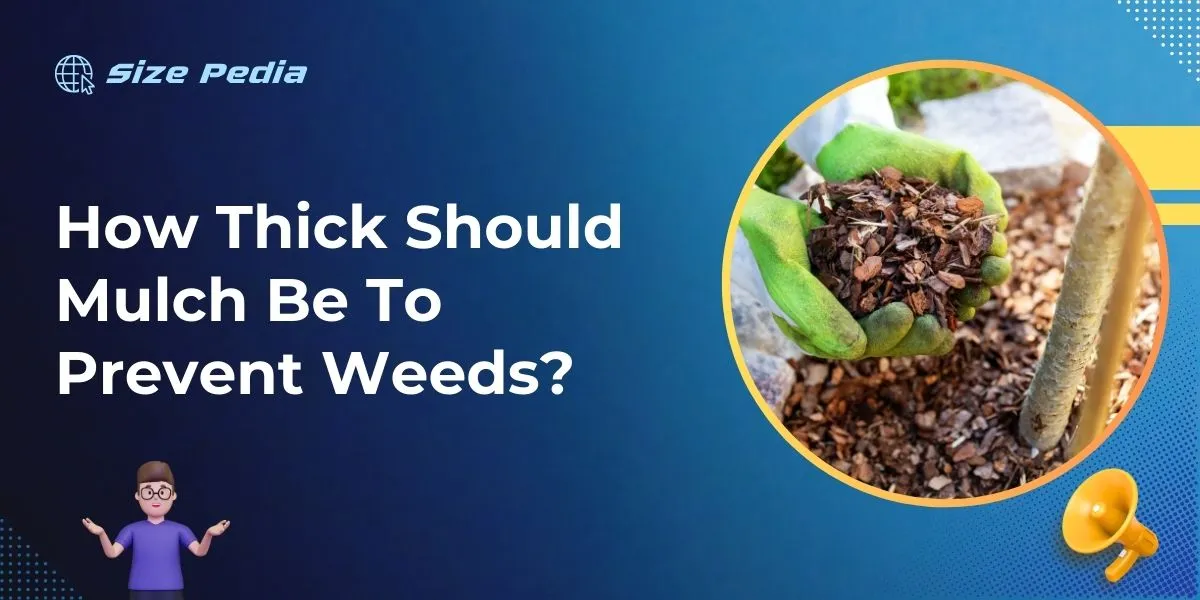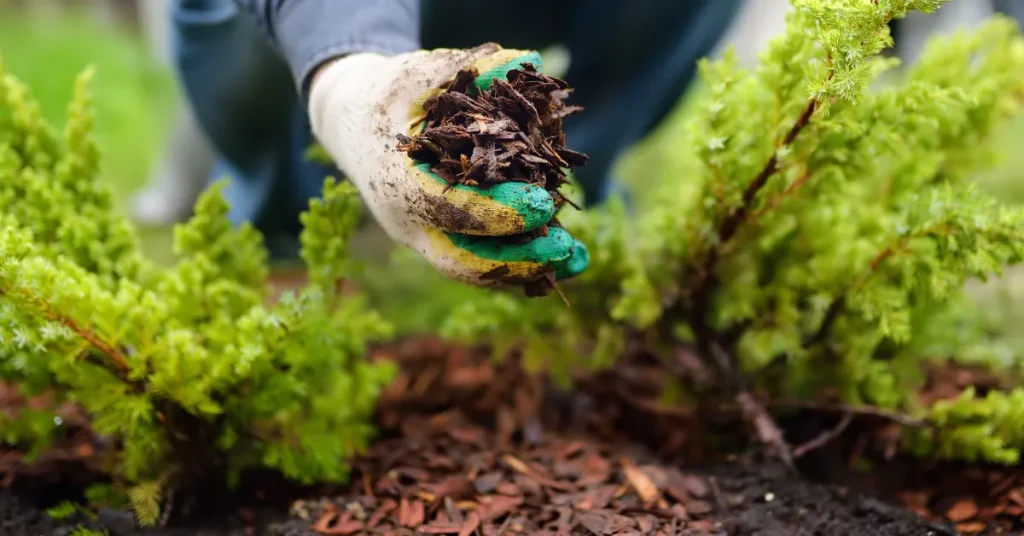Mulch should be applied 2 to 4 inches thick to effectively prevent weeds. Exceeding this can hinder plant growth.
Applying the right thickness of mulch is a key strategy for weed control in gardens and landscape areas.
This barrier not only suppresses unwanted plants but also retains soil moisture, regulates temperature, and adds organic matter as it decomposes. Too thin a layer won’t stop sunlight from reaching weed seeds, allowing them to germinate.
Conversely, too thick a mulch blanket can suffocate plants and disrupt water infiltration. By maintaining the recommended depth, gardeners can enhance the health and appearance of their landscaped spaces, while minimizing the effort required for weed maintenance.
Careful mulch management contributes to a tidy, productive garden ecosystem, benefiting both plant life and garden aesthetics.

The Purpose Of Mulch In Weed Control
Mulch serves as a barrier, blocking sunlight from reaching weed seeds. Without light, weeds cannot grow. This natural method limits the need for harsh chemicals. Gardeners find mulch valuable in their fight against unwanted plants.
Key Functions Of Mulch
Mulch performs several critical roles in maintaining a healthy garden:
- Retains soil moisture: Mulch helps soil keep water, reducing the need for frequent watering.
- Regulates temperature: It keeps roots cool in summer and warm in winter.
- Enriches soil: Organic mulches decompose over time, improving soil quality.
- Beautifies landscapes: Mulch can add to the visual appeal of your garden.
Why Thickness Matters In Mulching
A mulch layer too thin will not effectively prevent weeds. Thickness plays a crucial role.
| Material | Recommended Thickness |
| Bark Mulch | 3 inches |
| Straw Mulch | 6 inches |
| Grass Clippings | 2 inches |
The ideal mulch thickness varies based on the material used. Too much mulch can suffocate plants. Aim for a balance to block weeds successfully.
Ideal Mulch Thicknesses For Weed Suppression

To combat weeds effectively, the thickness of your mulch layer is crucial. An optimal mulch layer acts as a barrier, blocking light and inhibiting weed seed germination.
Understanding the right depth ensures a well-maintained garden with minimized weed growth.
Maximum Effectiveness With Optimal Depths
For maximum weed suppression, a mulch layer of 3 to 4 inches is recommended. This depth suffices to reduce light penetration and conserves soil moisture, creating an unfavorable environment for weeds.
Note that these measurements can vary with mulch type and garden conditions.
Consider these key points for optimal mulch thickness:
- Maintain a consistent layer across the garden bed.
- Avoid piling mulch against plant stems to prevent rot.
- Refresh mulch periodically, as it decomposes over time.
Variations Based On Mulch Types
Different mulch materials influence the layer’s effectiveness and longevity. Here’s a quick guide to the thickness required for various mulch types:
| Mulch Type | Ideal Thickness |
| Organic Mulch (Bark, Straw) | 3 to 4 inches |
| Inorganic Mulch (Stones, Rubber) | 2 inches |
Remember, organic mulches decompose and enrich soil. This means they require topping up more frequently. Inorganic mulches often last longer, but they don’t improve soil fertility.
Adapt the mulch depth to your chosen material for best results.
Comparing Organic Vs. Inorganic Mulches
Picking the right kind of mulch is key to effective weed prevention. Gardeners choose between organic and inorganic options, each influencing mulch thickness needed. Let’s drill down into the merits and drawbacks of both mulch types in combating weeds.
Pros And Cons For Weed Prevention
| Mulch Type | Pros | Cons |
| Organic Mulch | Enriches soilRetains moistureBiodegradable | Requires replenishmentMay attract pestsVariable weed block efficiency |
| Inorganic Mulch | Long-lastingLow maintenanceEffective weed barrier | Does not improve soil healthHarder to removeCan be less eco-friendly |
How Material Affects Required Thickness
Different materials alter the optimal thickness for mulch layers. Organic mulches decompose, hence a thicker layer ensures longevity.
Contrast that with inorganic options which stay put, requiring a thinner layer to combat weeds.
- Organic Mulch – Start with a 4- to 6-inch layer.
- Inorganic Mulch – Usually a 2- to 4-inch layer suffices.
Determining the ideal mulch thickness hinges on the choice between organic or inorganic material. Each possesses unique characteristics that inform the required mulch depth for effective weed prevention.
Practical Tips For Applying Mulch

Mulch not only enhances garden aesthetics but also plays a critical role in weed suppression and soil health. To optimize its benefits, proper application proves essential. Discover practical mulching tips to maintain a healthy, weed-free garden.
Step-by-step Mulching Guide
- Select the right mulch for your garden type.
- Remove existing weeds to start fresh and clean.
- Prepare the soil by watering if it’s dry.
- Spread mulch evenly, targeting a thickness of 2-4 inches.
- Avoid mulch contact with plant stems and tree trunks.
- Water mulch after application to settle it into place.
Common Mistakes To Avoid
- Too much mulch can suffocate plants and attract pests.
- Applying mulch unevenly leads to variable weed suppression.
- Ignoring local mulch materials can miss out on eco-benefits.
- Neglecting to replenish mulch weakens its effectiveness over time.
- Using contaminated mulch can bring diseases to your garden.
| Mulch Type | Thickness |
| Organic | 2-4 inches |
| Inorganic | 1-2 inches |
Mulch Maintenance For Long-term Weed Management
Mulch is a superhero in your garden, keeping weeds away. But like all heroes, it needs a little care to do its job well.
Knowing how much mulch to lay down and how to keep it fresh can save your garden from unwanted plants. Let’s dig into the secrets of keeping mulch perfect for stopping weeds year-round.
Refresh Frequency For Optimal Depth
Mulch needs a top-up now and then to stay thick enough. Aim for a refresh once a year. Keeping mulch 2 to 4 inches thick is key. This depth blocks the sun, stopping weeds from growing.
- Spring Refresh: Top up mulch at the start of the growing season.
- Autumn Check: Before winter, check depth and top up as needed.
Signs Your Mulch Is Too Thin Or Too Thick
Watch for clues that your mulch isn’t just right. They tell you if it needs more or less.
| Too Thin | Too Thick |
| Weeds pop upMulch scattered by windSoil dries out fast | Plants have weak stemsMold or fungus appearsWater runs off, not soaking in |
If these signs appear, adjust your mulch to get back to the sweet spot of 2-4 inches. Your garden will thank you with fewer weeds and happier plants.
Beyond Thickness: Other Considerations
When striving for a weed-free garden, mulch thickness is key, yet other factors also play vital roles.
Achieving the ideal garden condition requires thoughtful mulching beyond just the depth. Let’s explore some important aspects of mulching that complement its thickness.
Soil Health And Mulching
Healthy soil supports strong plant growth, making it a crucial ally in weed prevention. Here’s how proper mulching contributes to soil health:
- Maintains moisture, reducing the need for frequent watering
- Regulates soil temperature, keeping roots comfortable
- Encourages beneficial organisms that break down organic mulch into vital nutrients
Choosing The Right Mulch For Your Garden
Selecting the appropriate mulch can make a world of difference. Consider:
| Mulch Type | Best For | Prevention Level |
| Organic | Nutrient-rich soil | High |
| Inorganic | Longevity | Medium |
| Rubber or Stone | Low-maintenance areas | Low |
Note the function you need from mulch. Is it to enrich the soil, suppress weeds, or both?
FAQs About How Thick Should Mulch Be To Prevent Weeds
Will 3 Inches Of Mulch Kill Weeds?
Applying 3 inches of mulch can effectively suppress weeds by blocking sunlight and hindering weed germination, but it may not kill all existing weeds.
Is 4 Inches Of Mulch Too Much?
Yes, 4 inches of mulch can be excessive. Aim for 2-3 inches to prevent issues like rot and suffocation of plant roots. Too much mulch can hinder water and air reaching the soil.
What Is The Best Type Of Mulch To Prevent Weeds?
The best type of mulch to prevent weeds is a thick layer of wood chips or shredded bark. These materials block sunlight, inhibiting weed growth effectively.
Will A Thick Layer Of Mulch Prevent Weeds?
A thick layer of mulch can effectively suppress weeds by blocking sunlight, but it’s not foolproof. Over time, some weeds may still emerge through the mulch.
Conclusion
Determining the ideal mulch thickness is crucial for weed prevention. Aim for a layer between 2 to 4 inches. This balance fosters plant health and blocks sunlight, hindering unwanted growth.
Remember, proper application will enhance your garden’s beauty and health, keeping those pesky weeds at bay.
Resources:
1. https://extension.umn.edu/planting-and-growing-guides/controlling-weeds-home-gardens
